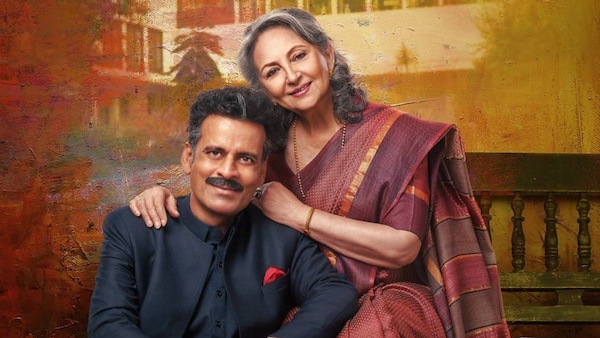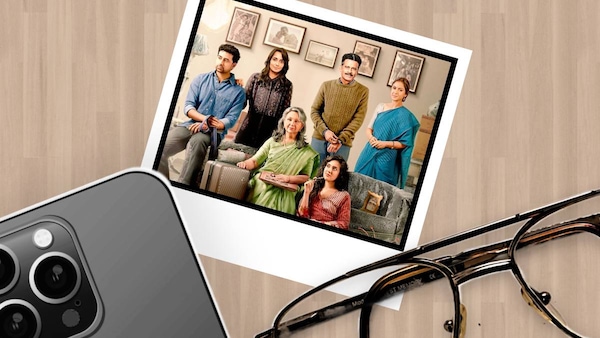Gulmohar: Sharmila Tagore-Manoj Bajpayee Family Drama Falls Just Short Of Good
This is #CriticalMargin, where Ishita Sengupta gets contemplative over new Hindi films and shows. Here: Disney+ Hotstar's Gulmohar.

Last Updated: 12.01 PM, Mar 03, 2023
RAHUL V CHITTELLA'S GULMOHAR is a strange little film. The oddity here is not a stray thematic detour, or a character arc that refuses to make sense. On the contrary, it is pretty formulaic in premise: a picture-perfect family is compelled by circumstances to confront relationship fault lines. Misgivings and resentment simmer at the fore, while resolution awaits in the distance. It is what comes out of it — the film itself — that is confounding . This is because Chittella’s debut feature seems to stand at the crossroads of consequences, like it is one scene shy from stealing the scene, a moment away from seizing the moment. By all intent and purposes, Gulmohar is a strange little film that is at the very brink of being good.
It is a precarious place to be in, since for the longest time the narrative flows. The dialogues work, the lived-in familiarity of the family oozes from the frame. When a middle-aged couple, Arun and Indu (Manoj Bajpayee and Simran) engage in banter and she teases him as “Stephenian” and he counters with, “you, across the road!” the extent of the life they have shared is established in one broad stroke. When the matriarch of the family, Kusum Batra (Sharmila Tagore) sips on a glass of brandy and in a room full of people, her son Arun cautions her slightly, the moment encloses such intimacy like it was supposed to be between them and us witnessing it is incidental. When a woman mimics her mother-in-law within closed doors, only for those words to be repeated, this time from the mouth of the older woman, no narrative devices are needed — nor used — to enact the proximity of the family.
It is in these little instances when Gulmohar shines. To be fair, it would have been criminal if that wasn’t the case. Sample the cast: Simran, Bajpayee, Tagore, Amol Palekar, Suraj Sharma, Chandan Roy among others. Give them a line and they will make it sing (although Tagore’s lilting way of enunciating comes across a bit jarring). But it is also the writing (Chittella and Arpita Mukherjee share the credit) that, for a while, is so charming that it offsets any grouse one might have against expected arcs. It is when the conflict starts that the film falters. The predictability of the premise hampers its potential, outlining the distinct legacy of Gulmohar — a film that will be remembered for what it could have been and not what it is.
The story is simple: a family residing in an upscale neighborhood of Delhi is selling off their house. When we meet them, they are in a mood of celebration. It is their last night together. In four days, the place will change hands. They will relocate to Gurgaon. Arun’s son, Aditya (Suraj Sharma), however, will live in a separate flat with his wife. Amidst the revelry, Kusum shares her decisions: she would like the family to spend the last few days in the house (and not at a hotel as planned) to celebrate Holi together. And post that, she will live in Pondicherry, alone.
Using the eventual loss of the one thing that held them together as the backdrop, Chittella examines the aftermath of it: the crisis of belonging, the resistance to change. That their bonds are tested while the house is in a state of desertion — the furniture is being packed, things get broken — not just serves as a cogent metaphor of the eventual refamiliarisation of the family but also mirrors their personal flux. After all, when the answer to the larger question ‘what are we?’ is threatened, it inadvertently opens up the space to confront a personal query: ‘who am I?’
The problem for a film like this starts when the dysfunctionality feels too engineered and the treatment comes across as too heavy-handed. Gulmohar falls in the same trap. For some reason, Chittella drops the rewarding subtlety midway and resorts to showing more than telling. A flashback sequence feels unnecessary, as does his device of cultivating empathy among the three generations by placing them on similar ground. It is not that it is implausible but the way it is done here comes across as forced. More crucially, it hints at the filmmaker’s reliance on easy resolutions. As a result, the film loses momentum. Across its runtime, Gulmohar introduces several characters but at the end of it, not many can justify their presence. In all probability, it would have been better had the outing been less crowded and more astute in its observation.

The writing only dampens as the film progresses. Characters spell out subtexts, as one confrontation piles on another confrontation, both looking at the same easy way out. A designed scene during an office interview is so tonally off that it seems borrowed from a different film. There is also an unearned scene between two former lovers, aesthetically influenced by the famous corridor moment in Mani Ratman’s Dil Se..(1998). But the script’s inclination to manufacture conflict manifests most sorely in the twist it reserves for the end. It is not so much for what it is hiding as the way it chooses to uncover that is the problem. For a film that remains steady and free of trappings for so long, a plot twist involving the magical presence of a man in Delhi from Jamshedpur, just where he should (not) be, feels too contrived.
This somehow reveals the filmmaker’s choice of prioritising narrative segues over characters to drive his point home. It is a pity because the actors in the film are compelling. Simran’s portrayal as the Tamil woman married to a Punjabi man with a Bengali mother-in-law is pitch-perfect. The physicality of her portrayal stands in telling contrast with Tagore’s poise. The latter, who appears on screen after an age, lends an entire backstory to her role through her presence. There is a tiny instance where she tells her domestic help, a young Muslim girl called Reshma, to pack things from the temple. If the religious undertones reveal themselves, it is solely due to Tagore’s existence in the scene. Sharma as the slacker son wanting to prove his worth to his father, is affectingly restrained. Roy’s role as a sidekick of sorts feels like an iteration of his Panchayat character but it is to the actor’s credit that he can make even repetition feel like novelty. It is Bajpayee though who carries the film on his slouched shoulders. The actor’s portrayal has no false beat even when the script refuses to be worthy of him. I was also taken by the little Monsoon Wedding ode Chittella sneaks in (he is a long-time collaborator of Mira Nair, having served as her creative and partner on a number of projects) primarily because of the actors involved.
In all honesty, I would gladly watch a film where these characters are sitting and bickering among themselves. I would also patiently wait for them to stop arguing and break into laughter. Such a moment comes in Gulmohar too. It is too late by then and it is too brief. But as Siddhartha Khosla’s music accompanies the scene and Tagore stands up, joining her family for a little dance, it is difficult to be unmoved by it. Some flowers need not wilt to be seen, some look best when they bloom.

 Premium
Premium